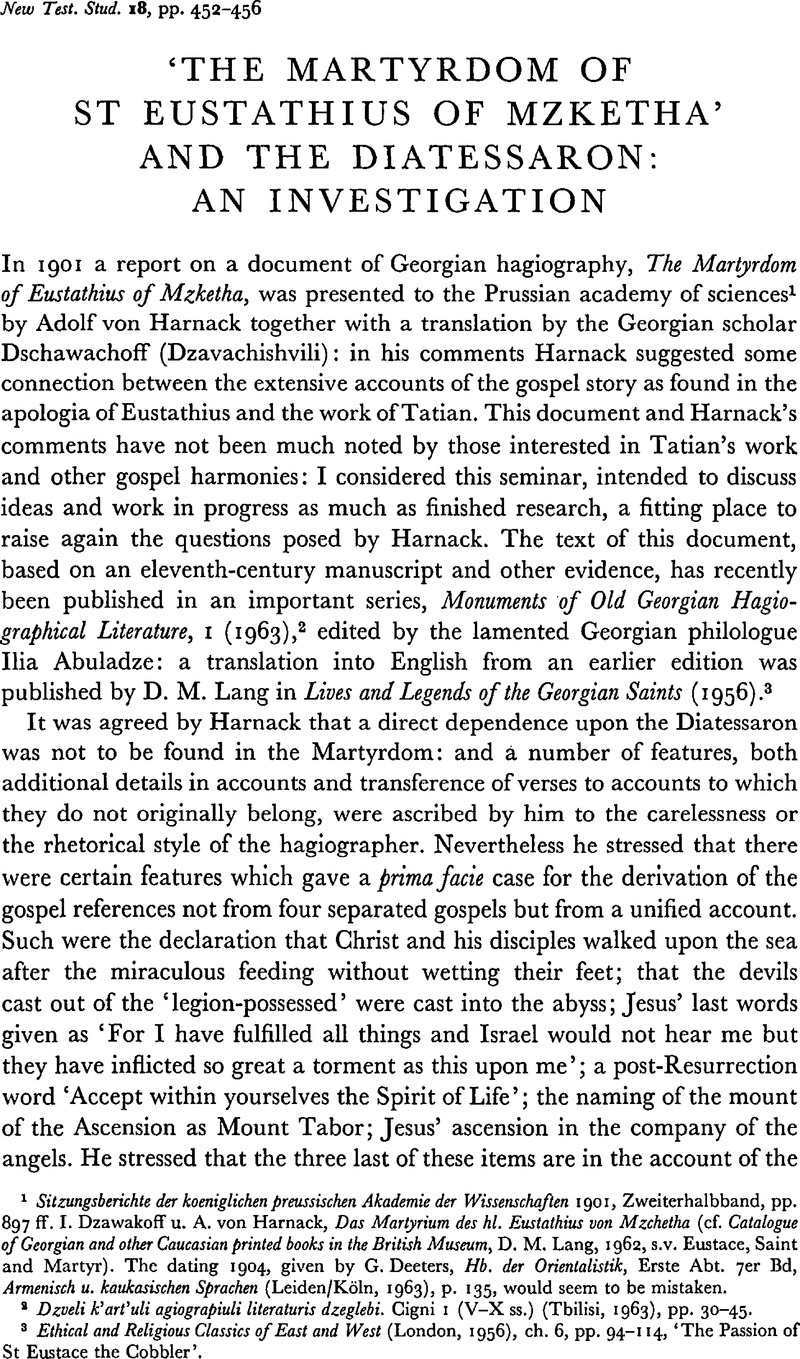Article contents
‘The Martyrdom of St Eustathius of Mzketha’ and the Diatessaron: an Investigation
Published online by Cambridge University Press: 05 February 2009
Abstract

- Type
- Reports of Noordwijkerhout Seminar
- Information
- Copyright
- Copyright © Cambridge University Press 1972
References
page 452 note 1 Sitzungsberichte der koeniglichen preussischen Akademie der Wissenschaften 1901, Zweiterhalbband, pp. 897 ff.Google Scholar I. Dzawakoff u. A. von Harnack, Das Martyrium des hl. Eustathius von Mzchetha (cf. Catalogue of Georgian and other Caucasian printed books in the British Museum, D. M. Lang, 1962, s.v. Eustace, Saint and Martyr). The dating 1904, given by Deeters, G., Hb. der Orientalistik, Erste Abt. 7er Bd, Armenisch u. kaukasischen Sprachen (Leiden/Köln, 1963), p. 135Google Scholar, would seem to be mistaken.
page 452 note 2 Dzveli k'art'uli agiograpiuli literaturis dzeglebi. Cigni 1 (V–X ss.) (Tbilisi, 1963), pp. 30–45.Google Scholar
page 452 note 3 Ethical and Religious Classics of East and West (London, 1956), ch. 6, pp. 94–114,Google Scholar ‘The Passion of St Eustace the Cobbler’.
page 453 note 1 The Old Georgian version of the gospel of Mark, ed. R. P. Blake, Patrologia Orientalis, XX, 3 (1928).Google ScholarThe Old Georgian version of Matthew, ed. R. P. Blake, Patrologia Orientalis, XXIV, 1 (1933).Google ScholarThe Old Georgian version of the gospel of John, ed. R. P. Blake and M. Brière, Patrologia Orientalis, XXVI, 4 (1955).Google ScholarLa version ancienne géorgienne de ľévangile de Luc, ed. M. Brière, Patrologia Orientalis, XXVII, 3 (1955).Google ScholarK'art'uli otkhtavis ori dzveli redakcia sami shatberduli ẖelnaceris miẖedvit (Two old recensions of the Georgian gospels according to three Shatberd manuscripts), ed. Shanidze, A.. Dzveli k'art'uli enis dzeglebi, 2 (Tbilisi, 1945),Google Scholar and cf. Glossarium Ibericum in quattuor evangelia et actus apostolorum composuit Joseph Molitor (CSCO Subsidia tt. 20, 21, 23, Louvain, 1962–1964).
page 454 note 1 Epistula apostolorum nach dem aethiopischen u. koptischen Texte herausgegeben v. Hugo Duensing. Kleine Texte 152, 1925, pp. 6, 7.Google Scholar
page 454 note 2 ‘thus’, esera; ‘this’, ese.
page 454 note 3 Ev. Petri. III. 6.
page 454 note 4 mouḥdes k'rist'esa zeda (ed. Abuladze, p. 41, l. 8): ‘they fell upon Christ’ (Lang's trans.): moụdes mas zeda (Act. Ap. vii. 57; L'ancienne version géorgienne des Actes des Apotres, ed. G. Garitte (Louvain, 1955), p. 56), text. graec. ⋯ρμησαν έπ'αύτόν
page 454 note 5 iamavri, found in Tobit vi. 15 (Greek μονογενής) and glossed in the Lexicon of Sulkhan-Saba Orbeliani as mẖolodshobili, ‘only begotten, only son’, the Georgian word used in the Old Georgian version at Luke vii. 12.
page 454 note 6 garna: (which renders пγήν; άλλά; et al.: see Molitor, loc. laud. s.v.). The Old Georgian tradition has twinier.
page 455 note 1 upqra ḥeli qrmasa mas (ed. Abuladze, p. 39, l. 12) ‘he took the boy by the hand’ (Lang's trans.); cf. Mark v. 41 and parallels: Mark ix. 27.
page 455 note 2 shemecie me rametu borotad viguemebi (ed. Abuladze, p. 40, l. 10) ‘succour me for I am sorely tormented’ (Lang's trans.), cf. shemecie, Mark ix. 22 translating βοήθησον ήμīν, and borotad iguemebis, Matt. xvii. 15 translating κακ⋯ς πάσκεı (or κακ⋯ς έκεı according to Molitor).
page 455 note 3 k'risteman sheẖrisẖna legionsa mas eshmaksa (Ibid.) ‘Christ was wrathful at the devil who was legion’ (Lang's trans.), cf. Mark i. 43 shehrisẖna = έμβριμησάμενος αύτῳ i. 25 = έπετιμησεν αύτῳ.
page 455 note 4 Ed. Abuladze, p. 38, l. 30; cf. Lang, p. 105, cf. Ephrem, S., Commentaire de L';évangile concordant, ed. Dom, Louis Leloir (Dublin, 1963), XIV, 91 (p. 123).Google Scholar
page 455 note 5 Biblia polyglotta matritensia. Series VI, Vetus evangelium syrorum et exinde excerptum Diatessaron Tatiani, ed. Ignatius Ortiz de Urbina S.J. (Madrid, 1967).Google Scholar
page 455 note 6 dzmari da navġeli shezavebuli (ed. Abuladze, p. 41, l. 12) ‘vinegar and gall mingled’, cf. dzmari navġelit shezavebuli (ev. Matth. loc. cit.) ‘vinegar mingled with gall’.
page 456 note 1 movida idumal (ed. Abuladze, p. 39, l. 27) ‘came by stealth’ (Lang's trans.); cf. dzrcoda mistvis romeli-igi qo man idumal ‘she was trembling about that which she had done secretly’ (Mark v. 33).
page 456 note 2 E.g. the wording of Matt. x. 32 (ed. Abuladze, p. 31, ll. 14 ff.; Lang, p. 96) accords fairly closely with the Adysh Ms, while the voice at the baptism (ed. Abuladze, p. 38, l. 29; Lang, p. 105) uses a vocabulary and order attested in the other four tetraevangelia known from publication (see p. 453, n. 1 above) and cf. the divergent textual data of Matt. xxvii. 34 and Mark v. 33 just referred to (p. 455, n. 6 and 456 n. 1). The student innocent of Georgian may check such points through the painstaking work of Molitor, J. in the following: Synopsis Latina evangeliorum ibericorum antiquissimorum (CSCO Subsidia t. 24, Louvain, 1965)Google Scholar and Glossarium Latinum–Ibericum–Graecum (CSCO Subsidia t. 30, Louvain, 1967)Google Scholar where a close and literal equivalence of translation is established and adhered to, not always to the enhancement of the Latinity, but certainly to the instruction of the textual scholar.
page 456 note 3 This is not to say that Diatessaric traces are not present in the separated gospels in Georgian: but that the harmony here discussed is posterior to the translations known to us and not their antecedent. (See further Arthur, Vööbus, Zur Geschichte des altgeorgischen Evangelientextes, Stockholm, 1953Google Scholar (Papers of the Estonian Theological Society in Exile, no. 4).)
- 2
- Cited by




